JRDG Company Special – Concentra 2
2001-2004
Retail price Coherence II in 2001 in the Netherlands 9.990 euro
Retail price Coherence II with Phono in 2001 in the Netherlands 10.990 euro
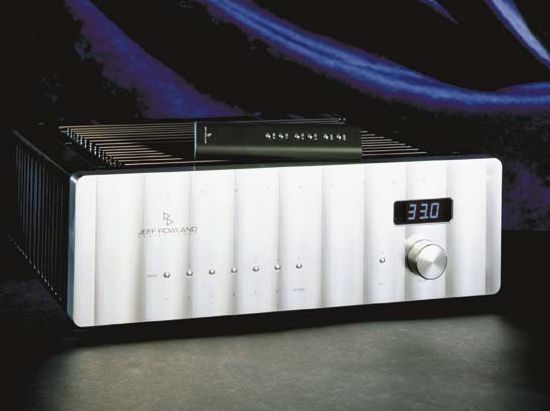
The Concentra II (1/2001 through 10/2003) is a 150 watt per channel integrated amplifier. It has a completely different power supply layout and design, in fact much more similar to the 112 power amplifier. The new layout is a much quieter source of power, and also has a separate front-end supply. The amplifier section has been derived from the model 10 and 112 power amplifiers, incorporating LM3886 integrated amplification circuits instead of bipolar transistors. See model 10, 12 and 112 for more info. The input section of the Concentra II is derived from the Synergy II preamplifier and utilizes a pair of audio input transformers. The Concentra II can be identified by its blue display and indicators.
Optional high-quality internal phono preamp modules were available for 1000 euro.
A good friend of mine has the Concentra II and I have heard it many times in his setup but somehow we never got around to comparing it to my model sixes. Nevertheless, because I know his system so well, I can safely say that the Concentra II indeed sounds like the ingredients that it is made of: a combination of the Synergy 2i preamp and 112 poweramp. It has all the finesse, low-level resolution and the fluid, airy and gentle treble as well as a colorful and romantic character. It is important to understand that although it really is marvelous, the Concentra II is not a universally applicable amp. Much like the Synergy 2i preamp, it can lack propulsion, speed and attack if the system it is placed in is unsympathetic. But match it with fast and open sounding speakers and the combination is stunning.
All Concentras have a balance control which makes sense because they contain a version of the Synergy preamp inside. Using the remote control, the balance will work but this just is not indicated on the front panel. To reset the balance, press “Mute” for a couple of seconds.
Although the C2’s mute function dims the display, and supposedly puts the unit in a low-power state, my friend still measured a power consumption of around 100 watts in that state. Compared to my Model sixes that use around 25 watts per side in standby, that seems really high.
The early Concentras had no possibility of putting it into standby or “sleep”. There is an option to upgrade early Concentra units with a “standby” mode that allows the unit to run cool and lower power consumption when not in use. Later models had this mode as standard. Standby mode is then engaged by pressing the “mute” switch after which the power transistors shut off and the unit consumes only a few watts. However, the original Concentra cannot be upgraded to Series II status.
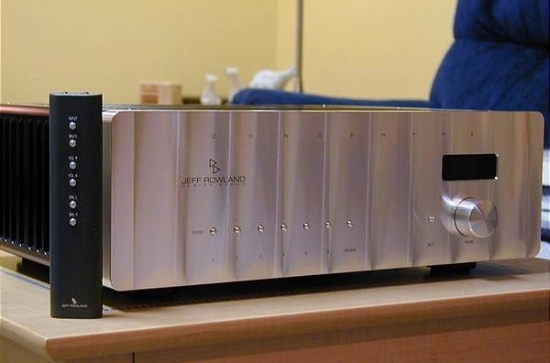
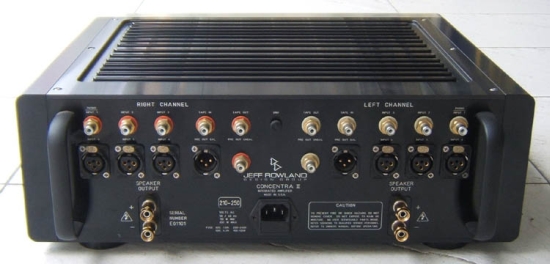
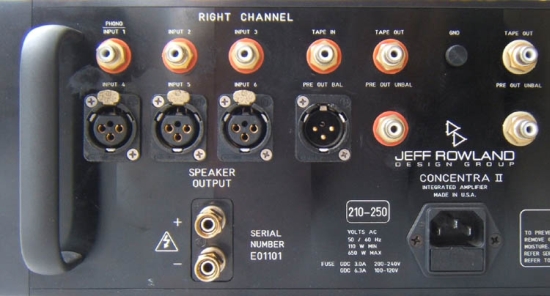
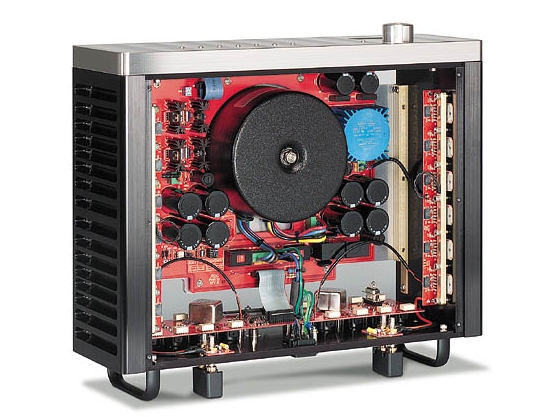
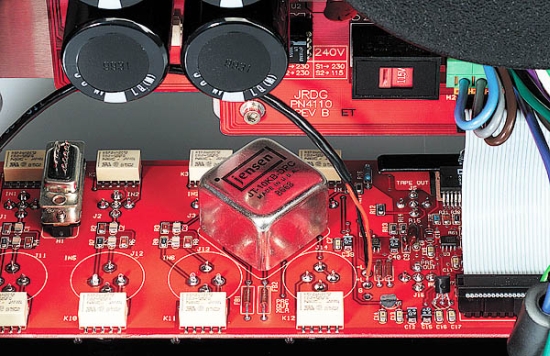
Above: Input transformer mounted on the rear panel, on the input/output board
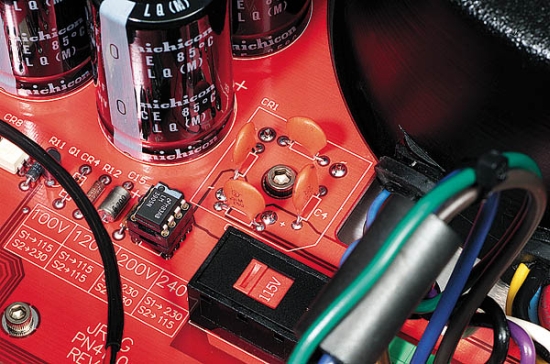
![]()
Above: LM3886 integrated amplification circuit up close. You can see that it has 11 pins, indicating that there is going on more inside besides simple amplification.
Concentra Technology
The text below has been re-published from content that was formerly available on the official Jeff Rowland website.
The amplifier output section of the Concentra II contains six power amplifier circuits per channel, each capable of 150 watts of peak power, incorporated in a novel “Intelligent Power Transistor with Gain” configuration. These output circuits are used in place of standard output transistors to provide unprecedented audio performance, stability, and reliability virtually impossible to achieve with conventional discrete components.
These integrated power output devices, or transistors, despite greater cost in comparison to their more commonly used discrete transistor counterparts, occupy very little circuit “real estate,” dramatically reducing capacitive and dielectric storage effects, as well as simplifying the overall signal path. Because of these lower capacitive and dielectric effects, open-loop bandwidth is approximately ten times greater than comparable discrete circuit designs and mid and high frequency distortion is lowered an order of magnitude while output impedance is also lowered dramatically, resulting in a much more accurate and musical presentation.
These devices also allow the added benefit of extremely accurate bias control and stability, whereas most other amplifier circuits must rely on “thermal bias.” Thermal bias is a process where a temperature sensor, most often a diode or transistor mounted to the heat sink, mimics the behavior of the output transistors and adjusts the bias current accordingly as it heats or cools – less current when hot and more current when cool. The greatest drawback with thermal bias is that there is a time delay of several seconds between the time the temperature of the output transistor changes and the temperature sensor reacts, as heat from the output device must slowly travel through the heat sink before it will arrive at the sensor. Typically, under conditions such as when music is playing, where the signal is changing instantaneously and bias requirements will vary quickly and continually, the bias adjustment will almost never be optimal for low distortion and the best possible sound quality since the bias adjustment will never catch up to the changing needs of the output transistors. Within the Concentra II, the temperature sensing is all performed directly within the output transistors themselves. This system allows the device to react as soon as demands change so that any and all bias adjustments are performed instantly and optimally along with the music – there is no delay between the time the temperature of the device changes and the sensor detects the change, as the sensor is an integral part of the device itself. In this way, distortion is lowered and reliability is dramatically increased to best serve the music while at the same time-saving cost.
One common question is whether the output section of the amplifier is biased into Class-A operation. Technically, the answer is “yes,” as the exceptional linearity of the output section design achieves the advantages of pure Class-A operation. Using the “Intelligent Power Transistor with Gain” system keeps the output section properly biased at all times to eliminate crossover distortion caused by the output transistors during turn-on and turn-off, as opposed to the brute force Class-A biasing techniques used in other inadequate amplifier designs to compensate for poor linearity that result in low efficiency, excessive heat, electrical waste, and the need for power management.
Yet another advantage of the output devices Jeff Rowland Design Group has chosen is that they have no inherent current limiting – only thermal limiting. Most amplifier designs use a monitoring system to detect current draw. If the transistors are drawing too much current, the output section will shut down so as not to destroy itself. Within the Concentra II, the output transistors have no limit to the amount of current they can safely draw: unless thermally challenged, the output transistors have no power limit. If the device is driven hard and detects an unsafe temperature, it will simply lower the bias until a safe temperature is reached and then resume at the optimal bias setting.
The output transistors within the amplifiers are securely clamped to a massive, non-resonant, machined aluminum heat sink via a rigid, custom machined aluminum bar. The heat sinks have been designed with a specific height, depth, and width in proportion to the front panel, rear panel, and top and bottom covers of the amplifier so that when all of the various parts of the unit are assembled, the amplifier as a whole does not resonate or vibrate. It also means that the entire chassis acts as a heat sink for better heat dissipation. This allows optimal and efficient heat transfer from the output devices and prevents any mechanical resonance or vibration under high power conditions from affecting the signal. During demanding musical passages, the amplifier is able to play cleanly and smoothly with no chance for excessive heat or ringing heat sinks to interfere with or affect sound quality.
Concentra Problem Solving
Coherence, Synergy, Concentra, and Concerto IR Remote Control lock-up
The remote controls for the above-listed products have an internal capacitor that can cause the microprocessor to lock when the battery has been nearly drained. This problem will continue even after a fresh battery has been installed. This capacitor allows the remote to continue to function even after the battery has become very weak. The solution to this problem is simple: remove the new battery and allow the remote to stand overnight with no battery installed. Once the battery is reinstalled in the morning, the remote should function properly again.
Complete lock-up
It can happen that the Concentra locks up when you operate many buttons at the same time and also adjust the volume. All you need to do is unplug the power cord, wait for 10 seconds and reconnect. If you reconnect too quickly, the Concentra may not work. The same is true if you swap the power cable or change the position in the extension block. As a rule of thumb: always wait 10 seconds before reconnecting the power.
Concentra 2 Features
TBC
Concentra 2 Specifications
TBC
More Jeff Rowland
Jeff Rowland Company Special Main Page
Jeff Rowland Company Special Integrated Amplifiers
Beste Christiaan,
Ik heb een Concentra II. Ooit gehoord op Audio Note speakers en dat ben ik nooit vergeten.
Ik krijg hem niet goed klinkend. Bij heel goede opnamen hoor ik wat destijds zoveel indruk op mij maakte: die vloeiende rijke klank met prachtig laag. Helaas klinkt het bij mij te vaak dun en onrustig in het hoog. Iets wat ik niet teruglees in de ervaringen van andere gebruikers.
Ik luister veel internet radio en spotify. Ik kan er nu bijna niet meer naar luisteren. Hoewel het niet de beste bronnen zijn; vind ik dat je ook dan moet kunnen genieten van de muziek.
Ik wil het nog niet opgeven met de Concentra II en ook mijn andere apparatuur wil ik (liever) nog niet aan de kant doen.
Daarom ben ik op zoek naar tips en tricks die ik zou kunnen uitproberen zonder al te veel te hoeven investeren. Heb jij hier – als ervaren JRDG-gebruiker – ideeën over?
Setup: Concentra II, Metrum HEX DAC, Bluesound Node 2, MIT AVT1 digitale coaxiale interlink, Siltech sq-28 classic mk2 anologe interlink (xlr), Monster m1 mk2 LS kabels. Speakers: Acoustic Analysing Oxford (Hepta).
Eerdere versterkers, die niet dun en onrustig klonken: Sugden A21a en Mark Levinson nr. 29. Hadden ook minder resolutie, minder controle en niet die rijke klankkleur.
Dank voor je reactie.
Hi Ruben, Concentra II is not itself a thin-sounding amp. It has “phat” bass but does lack some punch and articulation in the mid-bass. Perhaps this is what you are referring to. If so, no tweak will sort that. You’ll have to get another amp. If your issue really is only in the treble then there should be something that can be done as the CII has velvet-like smooth and airy treble and that part shouldn’t be the cause of the thinness you noted. Spotify lacks nuance and transient sharpness compared to better digital sources but this should also not be the cause of your issue. The first item that I would look at is the interlink and try to find a fuller, warmer sounding one. AudioQuest Water might be a good alternative as it has solid bass, good liveliness and a darker (but not too dark) treble. Also, have you tried reversing the power connector phase to the CII? It may also gain some fulness if it is powered directly from a wall outlet rather than via an extension block.
Beste Christiaan,
Dank voor je snelle reactie.
Ik ervaar geen probleem in het mid-laag. In mijn setup misschien zelfs wel een sterk punt van de C2. Nog geen reden om de C2 weg te doen.
Ik heb de juiste polariteit van de concentra ooit bepaald met een multimeter maar nooit meer mee geëxperimenteerd. Dat ga ik doen, alsook de C2 rechtstreeks op de wcd.
De Audioquest Water valt niet echt binnen budget. Zijn er nog andere interlinks die je (evt. 2e hands) zou kunnen aanbevelen in mijn situatie, die minder kostbaar zijn?
De Concentra 2 staat op harde voetjes, zou rubber nog iets positiefs kunnen toevoegen denk je?
Dank voor nieuwe ideeën (alvast).
Groet,
Ruben
Rubber feet make the treble sweeter indeed but they also soften the bass. It’s a matter of trying it out to see if it helps the overall balance. Personally, I’d leave the CII on its own feet and experiment only with the various cables. Other darkish and forgiving interlinks that are available second hand for attainable prices are Transparent Super, Cardas Golden Cross (warmer) or Golden Reference (more neutral).
Thanks a lot!
Hello Christiaan,
thought it would be nice to leave a comment on how your advice improved my setup. As a matter of fact, I can not tell exactly why, but the sound softened up quite a bit. Much richer sound now with less harshness.
After a lot of individual changes that didn’t do much good I changed several things at the same time. One of those things was plugging the Concentra directly in the wall outlet. The rest of the system is still in the extension block. This, together with positioning the speakers 2 cm closer to the back wall have improved the sound quite a bit. But based on the typical sound of the harshness that I experienced and the sound that I have now, I do think that the wall socket has done the trick. So thanks again!
Ruben
Glad it worked out Ruben!
Hi, I recently bought an used CII, but the LED display is always on. there is a switch to change the LED display to 5 sec off. Could you help to show me where is the location?
It’s supposed to be always on and there is no harm in that, the leds do not wear. However, I believe it should be possible to change the mode, only I forget how, and I have no documentation on this. My best guess would be a dip switch inside the IR Receiver unit.
Hello Christiaan,
Thanks for the reply. I found there is a discussion but not sure this is CI or CII because the CII seems need to open the bottom cover to see the switch…
CONCENTRA LED Volume Level Display
The LED Display on JRDG equipment operates in either of two modes. Constant display, or 5 second display. In the 5 sec. mode, the screen will be blank until a change in status (input select, volume level, etc.) is sent to the unit. The display will come on for 5 sec., then go blank again.
To change the Concentra display mode, remove the top cover and change the position of switch SW1 #2, the upper slide switch. It is located on the power supply regulator circuit board. It is necessary to reset the microprocessor after this change. Simply hold the mute button for 5 seconds and release.
SWITCH SW1
#1 = REMOTE CONTROL CODE SELECT
#2 = LED DISPLAY MODE
CONCENTRA POWER SUPPLY CKT. BOARD
Ah, I see now that you were referring to the Concentra II. Normally, in my experience, at least, when one mentions CII, they refer to the Coherence II, hence my earlier reply. In case of Concentra I, it is very easy to open the top or bottom cover as all electronics are mounted to the side panels. The Concentra II is built differently, but I don’t think you’ll need to open the bottom cover for that model. I’ll check with a friend who, until recently, owned a Concentra II, maybe he knows.
Thanks Christiaan in advance. I was referring to Concentra II, sorry for confusion
Alas, the friend who owned the Concentra II never experimented with the display settings.
No problem, I will keep the setting, thanks!
I have done this with mine.
The instruction looks familiar.
Opening the concentra is very simple.
Hello Ruben,
Do I need to open the top or bottom cover since this concentra II got one screw can’t be opened at the bottom and could you show me where is the switch location? Thanks
I am not sure nut the instructions states top cover.
This also makes sense if you’re not able to open the cover in the bottom.
Good luck!
*but the instructions state top cover
No problem, mate. I will double check
Hello, my Concentra 1 was already getting very warm. Now with the Concentra 2 (bought used) after about an hour of operation not only the side walls but also the lid get really hot. According to a test report in Image Hifi, the amplifier should only be lukewarm. Do you have any idea why this could be, or should I be worried? Thank you
Hi Markus, in my experience, all class A/B Rowland amps become quite warm, even recent ones like the 625 and 625 V2. This is a result of using quite high bias. Unless it is so hot you can’t touch the surface, I’d say it is normal. If in doubth, you could get a warmth measuring device to check the temp and ask Jeff himself.
Hello Christiaan, thank you very much for your comment. No, it doesn’t get that hot. I just thought that this heating wouldn’t be so good for the other components in the long run. But it’s great to get some feedback from another Rowland owner. Now I’m calmed down. Thank you
Your instinct is correct, and in theory, heat accellerates the aging of capacitors. Yet, Rowland amplifiers are one of the most reliable and ever-lasting in the business. 🙂
Hello Christiaan, I would like to give another update on the heat development, albeit late. The Rowland was previously in the compartment of my sideboard with a few centimeters of space to the sides and up. So with sufficient ventilation as I thought. I recently had the idea of placing the Rowland at the top of the sideboard for visual reasons. And what can I say, no more excessive heat development, on the contrary, the amplifier only gets lukewarm even after hours. I found that surprising, especially since I think it also has a positive effect on the sound. In the past, when it was still so hot, I actually found the sound in the treble to be sharper and not as relaxed anymore